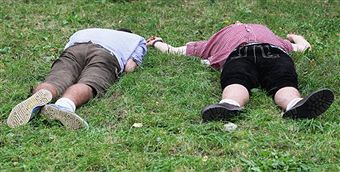 Professor David Nutt, the former Chief Drugs Adviser to the Government, has sparked
controversy again today by pronouncing that alcohol is more harmful than heroin, crack, powder cocaine and methamphetamine. His findings are
based on a paper published today, which builds on a 2007 journal that explored the same issues. So, is Professor Nutt right? If he is, what should the consequences be for public policy and, in
particular, our systems of drug classification and alcohol taxation?
Professor David Nutt, the former Chief Drugs Adviser to the Government, has sparked
controversy again today by pronouncing that alcohol is more harmful than heroin, crack, powder cocaine and methamphetamine. His findings are
based on a paper published today, which builds on a 2007 journal that explored the same issues. So, is Professor Nutt right? If he is, what should the consequences be for public policy and, in
particular, our systems of drug classification and alcohol taxation?
To find out, it is worth returning to Professor Nutt’s 2007 academic paper. The relative harm of drugs is measured according to nine meters, taking into account the various aspects of physical harm, dependence and wider social harms. The social harms measure includes health care costs and other harms such as damage to family and social life. Today’s paper uses a similar classification system – with the social harm measure pushing alcohol above every other illegal substance. However, the authors of the 2007 paper stressed very clearly that: “direct comparison of the scores for tobacco and alcohol with those of the other (illegal) drugs is not possible, since the fact that they are legal could affect their harms in various ways, especially through easier availability”.
However, since 2007, all of Nutt’s public forays into this debate appear to have airbrushed this crucial distinction. In fact, he now appears unable to stop himself from comparing illegal and legal harms. In January last year, in an effort to persuade the Government that the classification of ecstasy should be downgraded from Class A to Class B, Nutt wrote a journal article suggesting that taking ecstasy was safer than riding a horse. He even suggested, tongue firmly in cheek, that in order to tackle what he termed ‘equine addiction syndrome’, or ‘equasy’, horseriding could be banned. Then, twelve months ago, Professor Nutt gave a lecture in which he reproduced the same data (showing that alcohol was more harmful than many illegal drugs), but excluded the vital caveat that comparisons between legal and illegal activity cannot safely be made. In fact, he completely contradicted his earlier article, attacking MPs who suggested it wasn’t sensible to compare illegal and legal harms – accusing them of being trapped in an ‘illegality-logic loop’.
It stands to reason that alcohol – precisely because of its wide availability – causes the most social harm. Indeed, recognizing this, a recent Policy Exchange report recommended the overhaul of the alcohol duty regime to incentivise the consumption and manufacturing of lower-strength alcoholic drinks. However, if all mind-altering substances were legal, the picture would obviously look completely different. The problem is not only that Nutt has airbrushed his previous conclusion that comparisons of illegal and legal drugs cannot be made, but as a result, he then goes on to propose a completely new drug classification system in which alcohol, heroin and crack would become Class A drugs. For a scientist who has been at pains to point out the importance of independent scientific research (before he was sacked by the previous government), it does seem quite bizarre that he seems so keen to make sensationalist interventions that depend upon ignoring key qualifications from his own research. Independent experts frequently chide politicians for their selective and partial use of academic evidence. Professor Nutt would have more credibility if he didn’t appear to be guilty of the same offence himself.
Max Chambers is Senior Research Fellow at Policy Exchange






Comments